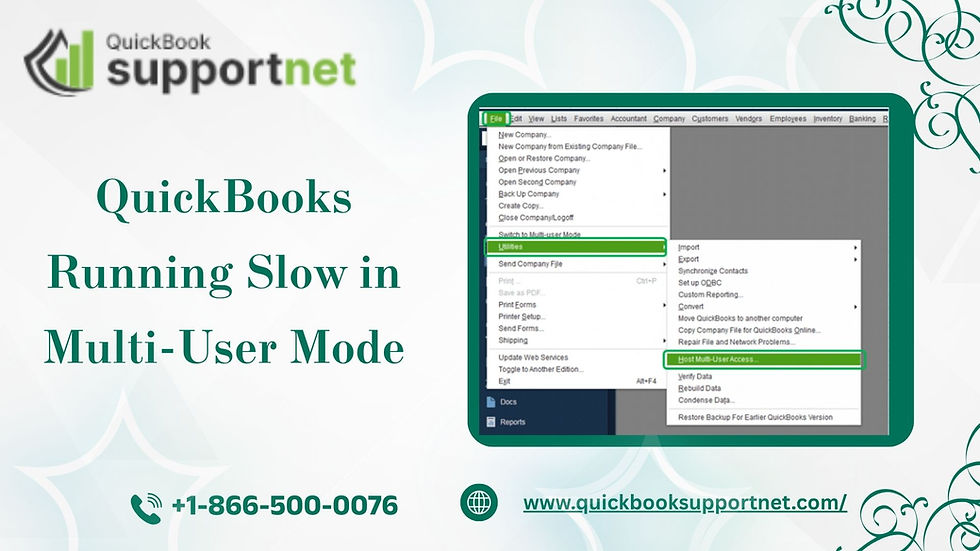Why is QuickBooks Running Slow in Multi-User Mode? Explained & Fixed!
- henrymaartin1990
- Jul 30
- 3 min read
When multiple users are working simultaneously on QuickBooks, it’s common to experience lag, delays, or freezing screens. If you're frustrated with QuickBooks Running Slow in Multi-User Mode, you're not alone—and thankfully, you're not stuck. This issue can directly impact your productivity and financial management, especially during peak hours or critical reporting periods.
In this article, we’ll explore the most common reasons behind this issue and provide practical, proven solutions that follow Google's content guidelines and real-world troubleshooting approaches.
Learn why QuickBooks Running Slow in Multi-User Mode and explore expert solutions to resolve it. Contact +1-866-500-0076 for quick assistance.

What is Multi-User Mode in QuickBooks?
Multi-User Mode allows more than one user to work on the same company file at the same time. It's a valuable feature for accounting teams, but it also requires a stable network and optimal system configuration. When those conditions aren't met, QuickBooks may become sluggish or unresponsive.
Common Symptoms of Performance Issues in Multi-User Mode
If your QuickBooks is slowing down in multi-user mode, you might notice:
Slow loading or freezing screens
Delay in accessing company files
Inability to switch between different modules
Frequent disconnection from the server
Syncing issues with shared data entries
Top Reasons Why QuickBooks is Running Slow in Multi-User Mode
Several factors can contribute to this frustrating situation. Here are some of the most common culprits:
1. Weak Network Infrastructure
A poor network setup or limited bandwidth is one of the main reasons for lag. QuickBooks relies heavily on a strong and consistent connection between client and server systems.
2. Outdated QuickBooks Version
If you're not using the latest release or update of QuickBooks Desktop, performance bugs can bog down your experience.
3. Improper Hosting Configuration
Incorrect hosting settings or having multiple systems hosting the file simultaneously can create serious conflicts.
4. Large Company File Size
Over time, your company file grows with data. A file too large in size (usually over 500MB) can slow down performance significantly.
5. Conflicting Third-Party Applications
Antivirus or firewall software may conflict with QuickBooks, especially if the firewall blocks specific ports used by the application.
Read This Blog: QuickBooks Error 15271
How to Fix QuickBooks Running Slow in Multi-User Mode
Follow these step-by-step solutions to boost performance and minimize downtime:
Step 1: Update QuickBooks and Windows
Make sure you are running the latest version of QuickBooks Desktop and that your Windows operating system is fully updated.
Open QuickBooks
Go to Help > Update QuickBooks Desktop
Click Update Now and restart your system after updating
Step 2: Verify Network Configuration
Ensure that your network setup meets QuickBooks requirements.
Use a reliable wired connection instead of Wi-Fi
Check that the Database Server Manager is installed only on the host computer
Assign a static IP to the server to reduce communication dropouts
Step 3: Adjust Firewall Settings
Configure Windows Firewall to allow QuickBooks access:
Open Windows Defender Firewall
Add exceptions for QuickBooks ports
Restart the system and check performance
If you need help with firewall configurations, don’t hesitate to call +1-866-500-0076 for expert assistance.
Step 4: Use QuickBooks Tool Hub
Download and install the QuickBooks Tool Hub, and run the QuickBooks File Doctor tool:
Close QuickBooks
Download Tool Hub from the official Intuit site
Run File Doctor from the Tool Hub to scan and repair your company file
Step 5: Optimize Company File
Reduce the file size to improve performance:
Run Verify and Rebuild Data Utility
Archive old transactions
Create a portable company file and restore it
Advanced Tips to Speed Up QuickBooks in Multi-User Mode
🟢 Store Company File on a Fast Server
Use a dedicated server with SSD storage and sufficient RAM to handle multiple users simultaneously.
🟢 Limit Background Applications
Ask users to close unnecessary applications while working in QuickBooks to free up memory.
🟢 Set Permissions Properly
Make sure all users have appropriate access rights without unnecessary admin privileges.
🟢 Switch to QuickBooks Enterprise (if applicable)
QuickBooks Enterprise is better optimized for larger files and more users.
Conclusion:
The key to resolving QuickBooks Running Slow in Multi-User Mode lies in identifying the root causes—be it network glitches, software conflicts, or oversized data files. With the right mix of system checks and QuickBooks optimization, you can restore speed and efficiency.
Don’t let sluggish performance hold your business back. Follow the guide above and make use of professional help when needed. If your issue persists or feels too complex, our experts are just a call away.



Men’s suede jackets are a game-changer for your style.They add a retro-modern feel to your everyday outfits.Highly recommend trying one if you haven’t yet.